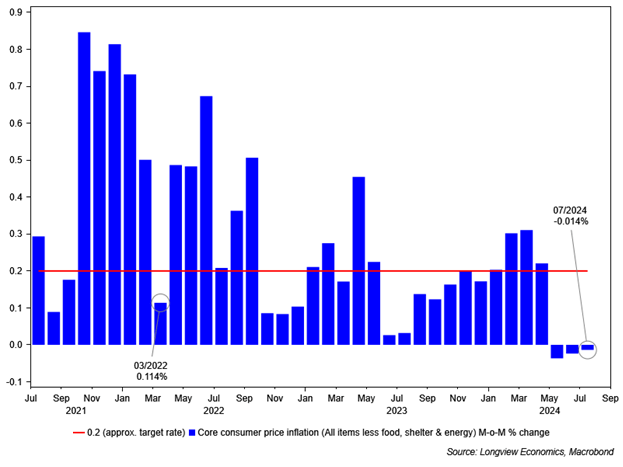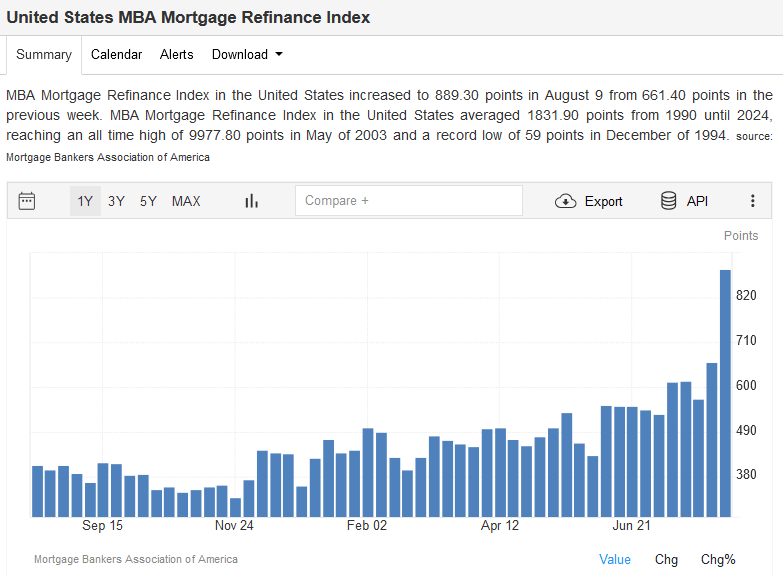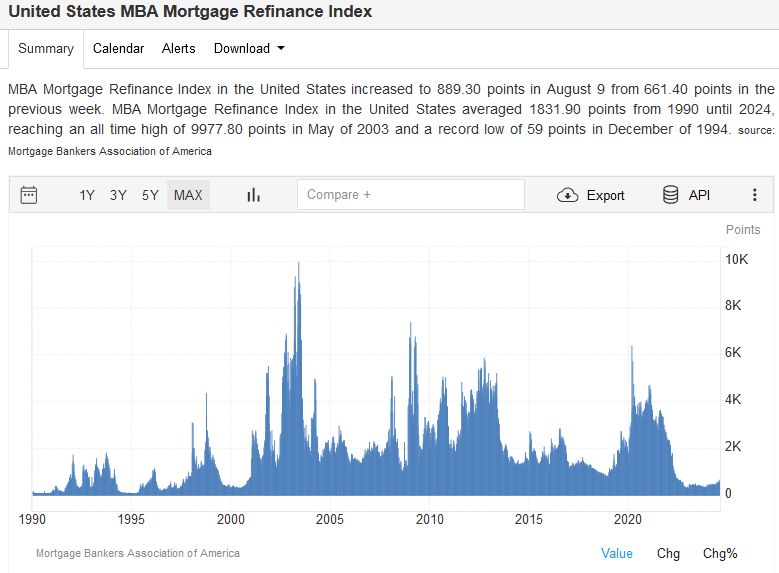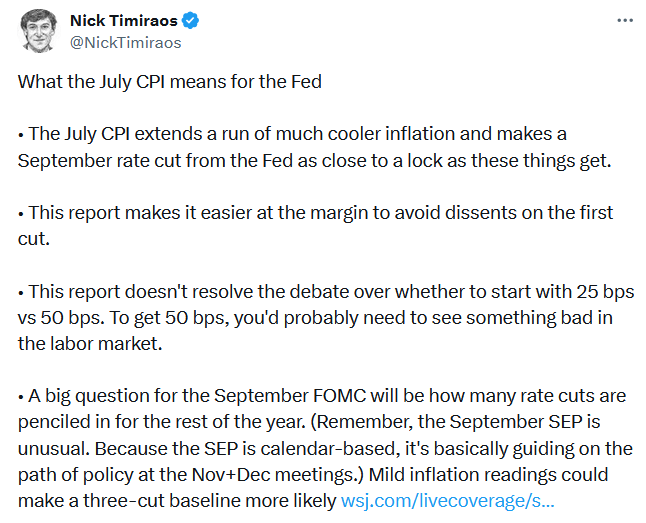Unlike this week’s cooler-than-expected PPI report, CPI was right on the screws. As expected, CPI and CPI core rose 0.2% for the month. On a year-over-year basis, they run 2.9% and 3.2%, respectively. The data pretty much locked the Fed into a 25bps ease at the September meeting, as Nick Timiraos states in today’s Tweet of the Day. However, despite the as-expected CPI print, the Fed may soon worry about deflation if you consider CPI without shelter prices. Sound crazy?
Core CPI without shelter prices was negative for the third month in a row. The last time it was negative for three consecutive months was from March through May 2020, when the pandemic had shut down the global economy. The CPI shelter index is up 5.1% over the last year. Furthermore, it accounts for 70% of the total year-over-year core CPI figure. We have harped on shelter prices on many occasions. To summarize, CPI shelter costs, accounting for 40% of CPI, lag significantly from real-time independent market data and the Fed’s New Tenant Rent Index. When, not if, CPI shelter costs catch up to market costs, 40% of CPI will head toward 0%. With it, the Fed may likely be moaning about insufficient inflation or dreaded deflation.
Remember, we are not alone in telling this story. The Fed and most economists know that inflation without shelter prices is below the Fed’s target. Moreover, they also understand the flaws in the CPI shelter data.
What To Watch
Earnings

Economy
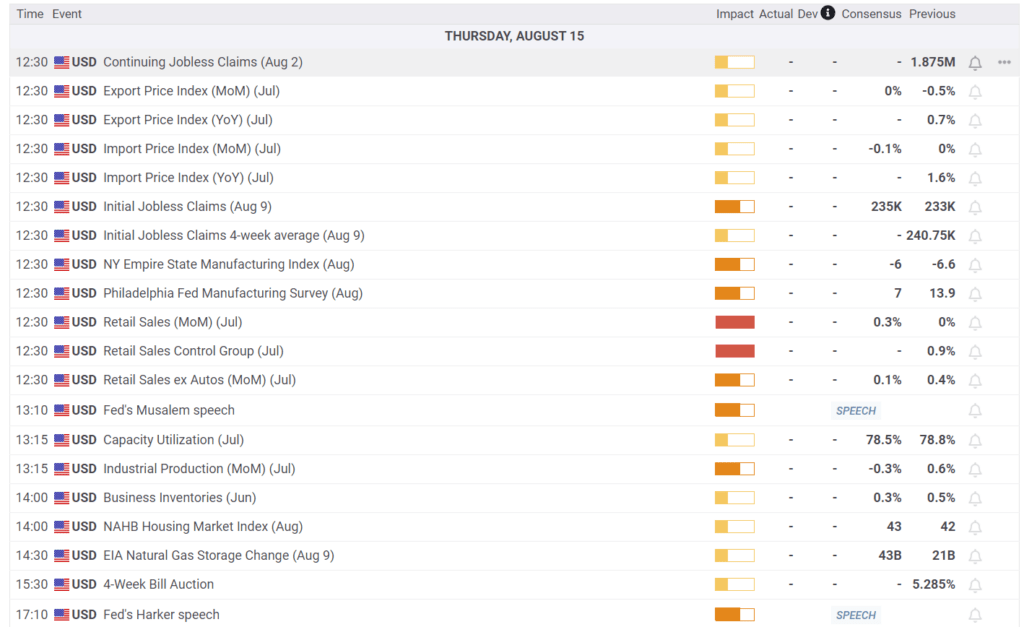
Market Trading Update
As noted yesterday, one of the market’s most important drivers is share buybacks, returning quickly as the earnings season ends. Those buybacks have helped propel a rather sharp market rally from the lows posted Monday before last and triggered a short-term MACD “buy signal.”
While this rally has been notable, the market currently faces resistance at the 50-DMA and is wrestling with the downtrend from the July highs. If the market can clear that resistance, a push towards 5600 becomes likely. However, given the magnitude of the advance, we still suspect a bit of a retracement back to the 100-DMA, which will likely provide key support in the near term. A successful retest of that support would likely provide an entry point to increase exposure slightly heading into October. Remain cautious for now.

Google Is In The Justice Department’s Cross Hairs
The Justice Department is considering various options for dealing with Google after it won its monopoly case against the company. One option being discussed is breaking up the company. Specifically, if this is the remedy, it would likely have to spin off its Android operating system. The Justice Department could take less drastic actions, like forcing Google to share customer data with its competitors.
At the center of the Google case are exclusive contracts. For instance, Google pays Apple approximately $20 billion a year to make Google a search engine default on Apple devices. Per Evercore ISI, courtesy of Reuters:
“The most likely outcome now is the judge rules Google must no longer pay for default placement or that companies like Apple must proactively prompt users to select their search engine rather than setting a default and allowing consumers to make changes in settings if they wish,”
Apple will also suffer if the Justice Department bans Google from entering exclusive contracts. Reuters claims that losing the $20 billion fee from Google could negatively impact Apple’s bottom line by 4-6%. The graph below shows Google is about 15% off of recent highs. Despite the recent market recovery, Google has been lagging. This Justice Department case is likely weighing on the stock.
Mortgage Refinancing Is Surging, Sort Of
The Fed tries to manage economic activity through its interest rate and QE policies. One critical aspect of their policy is its effect on the real estate markets. Low mortgage rates make home-buying cheaper and thus can spur home sales, which boost economic activity. Conversely, as we have recently seen, high mortgage rates curtail real estate transactions.
A second aspect of Fed policy and its effect on mortgage rates is the refinancing of mortgages. When people refinance their mortgage into a new lower-rate mortgage, they reduce their interest costs. Therefore, they have more money to spend on other items. Over the last twenty years, mortgage refinancings have had a powerful economic effect.
With mortgage rates approaching 6.25%, down almost 2% from last year’s high, some recent mortgagees are incentivized to refinance their mortgages. The first chart below shows that the MBA mortgage refinance index has nearly tripled over the last year. While this may appear significant, a glance at the longer-term graph shows that the index is still far from average. In fact, it is still below the troughs of the prior 25 years. Because the number of homes sold over the last few years has been below average, the number of potential refinancing will also be below average. This means that when the Fed does cut rates, its effect on the mortgage refinancing market will be much less than they are accustomed to.
Tweet of the Day
“Want to achieve better long-term success in managing your portfolio? Here are our 15-trading rules for managing market risks.”
Related: What Is NIXT?



